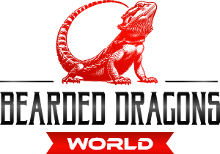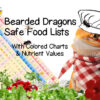Bearded dragon femoral pores are one of the distinctive features of these reptiles. The femoral pores are found on the inner thigh as with many lizard species. Underneath the femoral pores are the epidermal glands.
These small openings located on the underside of the lizard’s thighs play a significant role in the life of a bearded dragon. This is particularly so in male bearded dragons where they are more pronounced and serve as markers of sexual maturity and territorial behavior. The femoral pores become much more noticeable in maturity, which is typical of lizard species.
The anatomical positioning of the bearded dragon femoral pores are preanal and femoral. Not all lizards have femoral glands but most agamid lizards, including bearded dragons, do (Witten, 1993).
The number and layout of the pores differs in lizard species and as such is a characteristic used to describe and identify lizard species (Baeckens et al, 2015).
These pores secrete a waxy substance used for marking territory and during mating rituals. While generally low-maintenance, these pores can sometimes become impacted, leading to health issues. Ensuring the health of a bearded dragon involves regular monitoring of the femoral pores for any signs of impaction or infection, along with proper habitat maintenance. This entails providing an appropriate substrate, a clean environment, and offering correct nutrition to prevent health problems associated with these unique anatomical structures.
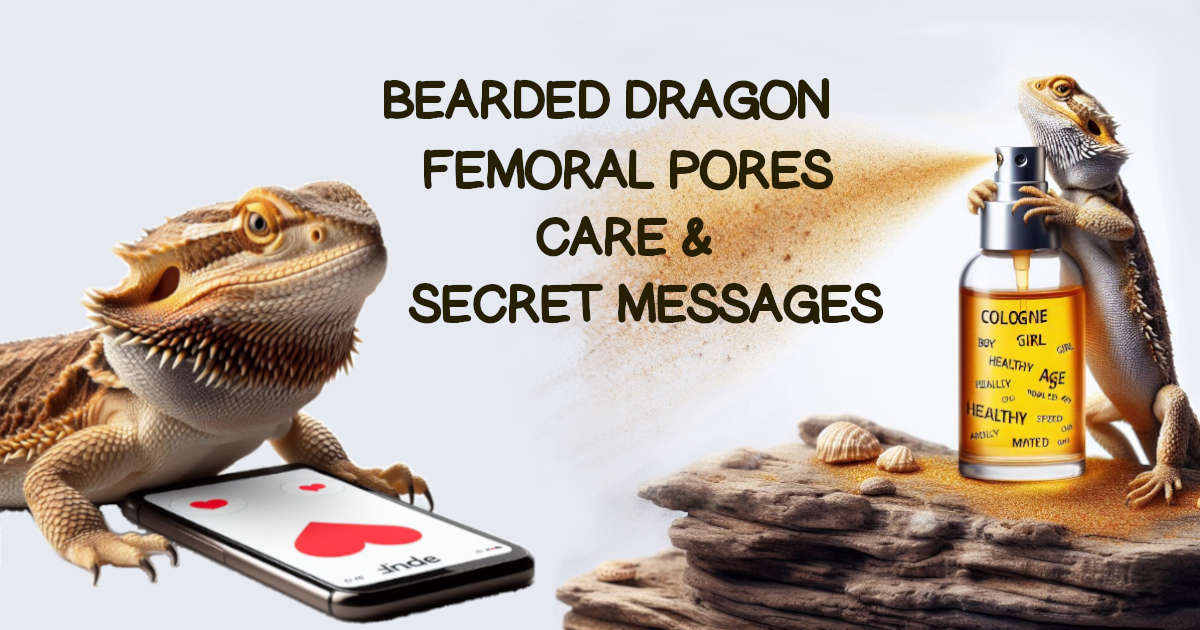
Jump To…
Key Takeaways
- The scents left by the femoral pores leave a message for other bearded dragons.
- Bearded dragons femoral pores are significant for marking territory and mating.
- Male and female femoral pores have some differences.
- Impaction in these pores can lead to health issues.
- Proper husbandry care of bearded dragon femoral pores is essential for their well-being.
- Clean femoral pores are important for bearded dragons’ health and communication.
- Recognizing the signs of clogged pores can prevent serious health issues.
- Clean femoral pores.
- Signs veterinary intervention is needed.
Purpose and Secrets Bearded Dragon Femoral Pores Reveal
What are the Dots on my Bearded Dragons Legs?
The little dots on the underside of a bearded dragon’s legs are called femoral pores. The two most widely accepted hypotheses for the purpose of the femoral pores are to secrete a chemical signature which:
- Lets males leave a scent to claim their space. “This is my spot!” (according to Brown, 2012; Mayerl et al, 2015).
- They help bearded dragons tell each other apart—figuring out who’s who and whether they’re male or female (Mayerl et al, 2015).
Femoral pores are part of the bearded dragon’s skin and are hooked up to glands that make a waxy substance (holocrine secretion) which helps them communicate without making a sound (pheromonal communication in lizards (Aragon et al, 2001).

What is the Waxy Sevretion Coming from the Femoral Pores? (Holocrine Secretions)
The femoral pores of a bearded dragon produce a waxy substance called holocrine secretion. The holocrine secretion is like a bearded dragons own body lotion, but instead of keeping their skin soft, it’s used for communication.
When the gland inside these pores makes the secretion, it fills up with this waxy stuff until the whole cell bursts and releases it. Although it sounds a bit gross, it’s an normal and important part of how they “talk” to other bearded dragons without making a sound, kind of like leaving a scented note for others to find.
The femoral pores (ducts) continuously and slowly release this thick waxy solid holocrine secretion known as a secretion plug (Imparato, 2007). The secretion in agamids is mostly protein (likely keratin), pheromones and other chemical compounds (Gans and Crews, 1992).
Dropping Bits of Waxy Secretions for Others to Discover & Decipher their Story
The waxy secretion is smeared on substrate and objects such as rocks, branches and vegetation within the male’s territory. Small pieces of the femoral secretion plug fall off onto the substrate leaving a chemical signature.
The secretions tell other lizards a lot about them, like what kind they are, how old they are, if they’re a male or female, and even how they’re feeling, health-wise (Baeckens et al, 2015). So, when male and female bearded dragons leave their scent behind, it’s like they’re dropping little hints about themselves for others to pick up on.
In studies Tegu’s were observed rubbing their thighs and cloacal region on the ground. The femoral secretion left on the ground was not obvious enough to see by eye however, the reactions of other males indicated they could very much detect the previous males scent (Chamut, 2009).
Similarly, when bearded dragons rub their thighs against things, it helps to scrape off some of that waxy buildup, keeping things balanced. But if their environment in captivity is not equiped with the rocks and branches for them to rub against, their femoral pores can get clogged up.
The duration of the scent markings depends on the substrate it is left on. For example, Regnier and Goodwin (cited in Baeckens, 2015) found that clay surfaces were slower to lose the scent than wood. During breeding season the glands secrete more and increase in size however the pore size stays the same (Mayerl et al, 2015). The make up of the secretion also changes during breeding season.
Beared Dragons may be able to See Femoral Pore Secretions as well as Smell Them!
Secretions are made of keratin, protein, fats, and some smelly compounds. Funk (2002) wrote about experiments with the desert iguanas and their attraction to objects with secretions on them. More importantly, these secretions glow under UV light, which means lizards might actually see them while chilling in their habitat.
Now we have understood what the waxy secretions from the pores are for, lets assume is also true for bearded dragons that they can see the secretions (no scientific evidence found). This would mean that lizards living together in the same environment, where some keep marking its territory with these secretions, could be stressing out other lizards.
Where are the Femoral Pores Located?
Femoral pores are located on the underside of the hind limbs, embedded along the inner thigh. Each pore is connected to a gland that secretes a waxy substance used for communication.
Male and Female Bearded Dragons Have Femoral Pores
Both male and female bearded dragons have the femoral pores on their legs, but they’re a bit different between the two. Males have more femoral pores and they are bigger. They ooze a waxy secretion that contain pheromones. It’s like their own personal cologne, playing a big part in their lizard social life.
Female Bearded Dragon Femoral Pores
Female bearded dragons have femoral pores but they are much smaller than males (Bowmanville Veterinary Clinic; Avian and Exotic Animal Care; Pine Tree Veterinary Hospital).
Mayerl et al (2015) found that the glands in female lizards become active only before mating, helping males identify females that are not yet mated. However, there’s a lack of evidence to fully support this finding. The same study noted that research on this aspect of female lizard behavior is limited, with significantly more attention given to males.
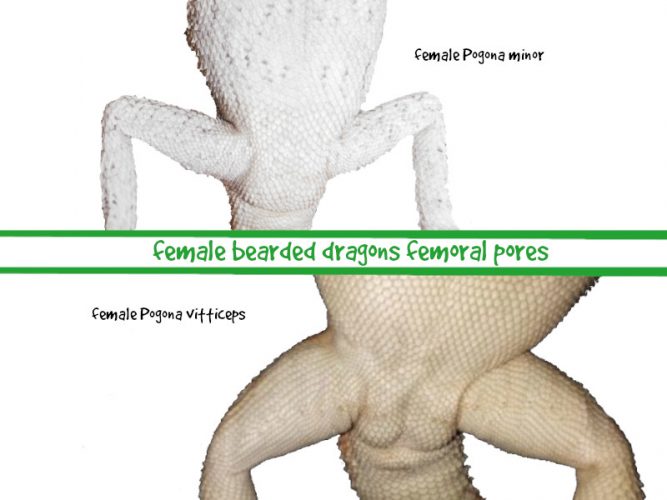
Femoral Pore Secretions are like Tinder for Female Bearded Dragons – Swipe right?
Female lizards can pick up on what the secretions reveal and assess how good a mate he will be, its kind of like is it ‘will it be love at first smell?’.
Mayerl et al (2015) reviewed studies on what a female lizards can detect from the chemical signature of the secretions. Amazingly females can pick up on, and subsequently favour, the quality of a male from the scent of the secretion. Female lizards are so adept at reading the chemical signature that they were able to detect the quality of a male such as size, health, diet and even its access to thermal resources.
The female Psammodromus algirus lizards demonstrated how capable they are of picking up on the quality of a male through their femoral pore secretions. The females were able to detect and show preference to male lizards with lower parasite infections and good immune responses (Mayerl et al, 2015).
In some species of lizards, females were even able to detect and show preference to areas marked with secretions by males with essential nutrients (Norris and Lopez, 2011; Mayerl et al, 2015). The essential nutrients of interest to the females included provitamin D, vitamin E and oleic acid.
The male secretions are so revealing that females of some lizard’s species have also been shown to be able to detect the age of a male. Females have a preference for older males (Mayerl et al, 2015).
Males Bearded Dragon Femoral Pores & Mating Season
Femoral pores are more prominent and active in males than in females.
Funk (2002) summarised that when male lizards are in their prime mating mode, these femoral glands go into overdrive and produce more secretions. Interestingly, if a male lizard is neutered, these glands shrink and don’t do much.
Padoa (cited by Cole, 1966) showed that castration of male lizards results in atrophy of the glands to a point where the glands replicated that of females. However, castrating females had no effect.
Injecting castrated males with testosterone propionate and dihydrotestosterone can restore some production of femoral gland secretions (Norris and Lopez, 2011).
The Role of Femoral Pores in Reproduction and Territory Marking
During mating season, male bearded dragons will increase the production of pheromones to attract female bearded dragons and to establish their presence to rivals.
The secretions provide important information regarding the male’s health, age, and reproductive status, and are left on surfaces when males crawl across loose substrate or rocks. This behavior is significant for marking territory and asserting dominance within a particular area. The femoral pores serve as visible cues to other dragons indicating ownership and discourage encroachment by competing males.
Secret Messages from Male Bearded Dragon Femoral Pores
Males leave secret messages for females as discussed previously. Males also leave messages for other males, potential rivals. The chemical signature of stools and femoral gland secretions provide information for male lizards to size up their potential rivals (Aragón et al, 2001).
In the male wall lizards, it was found that the chemical composition of the male’s scent markings changed based on basking resources and access (Mayerl et al, 2015). It has also been shown in some species of lizards that secretions varied with level of immune response giving away clues as to how healthy the lizard is (Mayerl et al, 2015).
Femoral Pores are Controlled by Androgens: The Key to Secretions
Femoral glands are controlled by androgens (group of hormones including testosterone). Studies show that hormones cause the increase in femoral gland activity during mating season.
Changes from Juvenile to Adult Bearded Dragons
As a juvenile bearded dragon matures, distinct physical changes occur in the femoral pores, which are glands located on the underside of the hindlimbs. These pores are more pronounced in males and tend to become visible as they reach sexual maturity, typically around the one-year mark. Males will exhibit larger and more prominent femoral pores, which secrete a waxy substance during the breeding season, assisting in marking territory and attracting females.
Seasonal Variations and Brumation Effect
The activity of femoral pores is influenced by seasonal changes, often linked to mating and breeding behaviors. During the breeding season, there’s an increase in the waxy exudate production, signaling the males’ readiness to mate.
Conversely, during brumation, a period of dormancy similar to hibernation in mammals, femoral pore activity diminishes significantly. This seasonal dormancy typically occurs during the colder months and can last for several weeks, resulting in reduced physiological functions including those of the femoral pores.
Problems with Femoral Pores
Over time, femoral pores can become clogged, potentially leading to health issues and diminished ability to communicate effectively.
Bearded dragons may experience health problems stemming from their femoral pores, such as infections or impaction. Spotting clogged pores early is key to preventing further complications such as impaction and pain.
Can Bearded Dragons Femoral Pores get Clogged?
Bearded dragons are naturally capable of maintaining their own femoral pores, something they do naturally in the wild. As pets they may not be provided with the right conditions that enables them to keep them clean. Without the right conditions or proper maintaince the pores can become clogged and impacted.
Three causes of clogged femoral pores and infection include:
- A deficiency in vitamin A (Eatwell, 2010).
- Insufficient humidity (Klaphake, UD).
- Inadequate rough surfaces to rub on (inadequate environment).
When the secretion plug starts to show it will appear as little more than a little bump poking out of the bearded dragon femoral pore. Once the secretion plug gets large the bump will get larger, jutting out of the pore perhaps slightly curled. If it becomes very overgrown it may appear something similar to a little worm, a hard protrusion curling from some of the femoral pores.
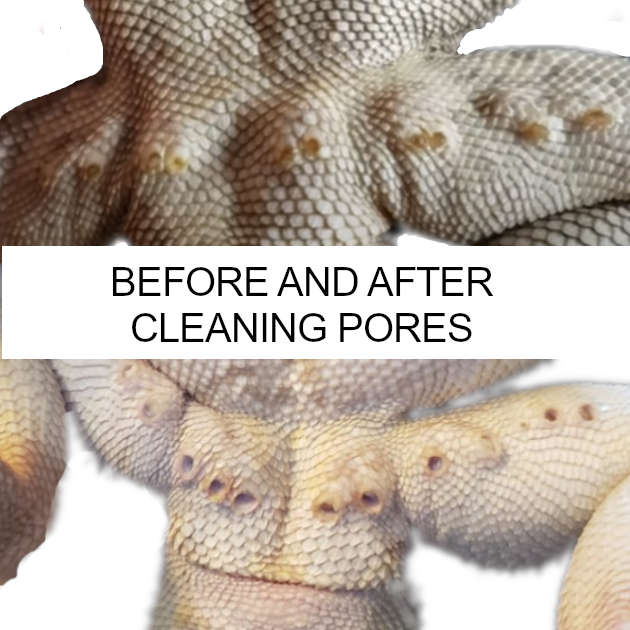
Identifying Clogged Pores
Clogged femoral pores on bearded dragons show as small waxy protrusions from the pores. The secretions can enlarge the pores, taking on the appearance of curled, worm-like plugs protruding from the pores.
Early detection is important to prevent the progression to femoral pore impaction, a more severe condition that can cause significant distress to the animal.
- Signs to look for:
- Small, bump-like protrusions on the skin near the thighs.
- Larger, hardened plugs that may curl outward from the pores.
Impacted Femoral Pores
When femoral pores remain clogged, a range of health issues can arise. These include painful impaction, swelling, and in severe cases, infection leading to abscesses. These pores can become infected indicated by:
- Pain or discomfort, especially when the area is touched.
- Swelling and potential abscess formation.
- Infections that may result in bleeding or pus-like discharges.
In research conducted by Sollom and Baron (2023) on the prevalence of disease in captive bearded dragons it was found that impacted femoral pores:
- made up almost 3% of 159 bearded dragons presented in general veterinary check-ups.
- made up 12% of 154 bearded dragons cases diagnosed with skin disease in veterinary visits.
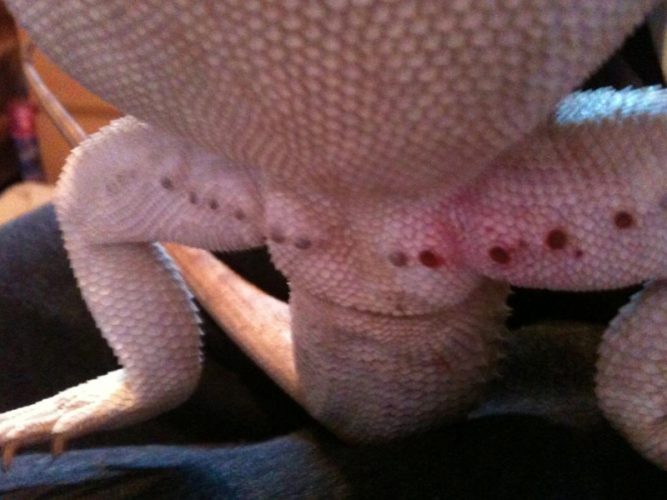
Do Clogged Femoral Pores Hurt?
Clogged femoral pores in bearded dragons may cause pain. Bearded dragons may show pain or discomfort when the area is touched. Additionally, if the infection is severe, there might be bleeding or a pus-like discharge.
Significant pain has been noted in iguanas when trying to remove excessive secretion plugs from swollen glands (Klaphake, u/d). In addition, bleeding may occur at a later time when basking as the warmth and improved blood flow can dislodge blood clots (Klaphake, u/d).
When Femoral Pores Need Veterinary Attention
If the femoral pores remain clogged or become infected, it is imporant to seek veterinary care. A veterinarian who specializes in reptile health can clean the pores more thoroughly and safely.
The bearded dragon femoral pores need veterinary attention if:
- It shows behaviour that indicates pain.
- The femoral pore is clogged and impacted. The secretion plug could be bigger than the pore it must come out of.
- The femoral pore is distended and bleeding.
Veterinarians may stem bleeding with a sterile cotton bud (Eatwell, 2010) and 2% chlorhexidine gluconate (Klaphake, UD). Along with good cleaning practices of the reptile keeper, the disinfectant will aid in reducing the risks of subsequent infection.
Maintaining clean femoral pores is vital for the health of reptiles, such as bearded dragons. Certain cases require professional medical interventions by a reptile vet to prevent severe complications like impaction and infections.
Cleaning Clogged Femoral Pores
Do You Need To Clean Bearded Dragons Femoral Pores?
Healthy femoral pores on a bearded dragon should appear as small, uniform bumps along the underside of the thighs. They should not be swollen, discolored, or have any discharge. Clear or slightly waxy secretions can be normal, especially in males during breeding season.
As long as the secretion from the femoral pores is not unusually long, the pores aren’t impacted, red or painful; then cleaning is not likely required. The secretion is a normal discharge with a purpose and does not need to be removed.
5 Steps to Clean Clogged Bearded Dragon Femoral Pores
Clean femoral pores by providing a warm bath and a gentle rub with a toothbrush. It may take a number of baths over a period of days if the femoral pores are clogged.
- Warm Bath: Begin by giving your bearded dragon a warm bath. Fill a container with luke warm (not hot) water, ensuring it’s shallow enough for your pet to stand comfortably. The water should reach about halfway up its legs. Let your bearded dragon soak for 15-20 minutes. This will help to soften the skin and any secretions blocking the pores.
- Gentle Brushing: After the soak, use a soft-bristled toothbrush or a cotton swab to gently brush over the femoral pores. Do this very gently to avoid irritating the skin. The goal is to help loosen any debris clogging the pores.
- Rinse: Carefully rinse the area with warm water to remove any loosened material. You can use a spray bottle or gently pour water from a cup.
- Dry: Pat your bearded dragon dry with a soft, clean towel. Avoid rubbing the skin, especially around the sensitive area of the femoral pores.
- Veterinary Care: If the pores are severely clogged or if there’s an infection, professional veterinary care may be necessary. A vet can safely extract the blockages and provide appropriate treatment to prevent complications.
What Can Go Wrong When Cleaning Femoral Pores
Cleaning impacted femoral pores in bearded dragons, if not done carefully, can lead to several complications. The major concerns associated with cleaning these pores include:
- Pain: The process can be uncomfortable or even painful for the bearded dragon, especially if the impaction is severe or if excessive force is used. Bearded dragons have sensitive skin around the femoral pore area, and any aggressive cleaning can cause distress or pain (Mader, 2006).
- Bleeding: The area around the femoral pores is rich in blood vessels, which can easily be damaged during the cleaning process. Aggressive or improper cleaning techniques can lead to bleeding, which not only causes immediate harm but can also lead to further complications (Mader, 2006).
- Subsequent Infection: Any time the skin is broken or irritated, there is a risk of infection. If femoral pores are not cleaned properly, or if the skin is damaged during cleaning, it can create an entry point for bacteria, leading to infection. Infections in this area can be particularly problematic due to the proximity to the reproductive organs and the potential for systemic spread (Mader, 2006).
If the pores start to bleed, apply an antiseptic ointment and stem the blood flow with gentle pressure using a sterile swab. If the bleeding continues, call your vet to discuss best course of action.
If impaction is suspected, it’s often best to consult a veterinarian experienced with reptiles to ensure safe and effective treatment.
Popping Bearded Dragon Pores
Popping bearded dragons femoral pores when they appear full is not generally recommended for pet owners. This practice can lead to several problems:
- Risk of Injury: Attempting to pop femoral pores can easily injure the delicate skin in this area. The skin around the femoral pores is sensitive, and applying pressure to express the contents can cause tears, abrasions, or more severe injuries.
- Pain and Stress: This procedure can be painful and highly stressful for the bearded dragon. Reptiles, including bearded dragons, can experience pain and stress which negatively impacts their health and well-being.
- Infection: Manipulating femoral pores can introduce bacteria into the pores or the surrounding skin, leading to infections. Infections in this area can be challenging to treat and may require veterinary intervention.
- Potential for Impaction: Improperly popping femoral pores can lead to further impaction. If the process is not done correctly, it can push the secretions deeper or cause swelling that blocks the pore, exacerbating the problem.
Given these risks, it’s best for pet owners to avoid attempting to pop or manually express femoral pores. If your bearded dragon’s femoral pores appear impacted or if there are any signs of infection (such as redness, swelling, or discharge), consult a veterinarian experienced with reptiles. A veterinarian can safely assess and treat the issue, often using methods that minimize pain and the risk of complications.
Preventing Femoral Pore Impaction
Maintaining a healthy environment for bearded dragons is key to preventing femoral pore impaction, a condition that can lead to health issues if not properly managed. Here are some guidelines to help pet owners create a safe and healthy habitat for their bearded dragons:
1. Choose the Right Substrate
The substrate, or bedding, in your bearded dragon’s enclosure plays a significant role in their overall health. Avoid loose substrates like sand or gravel, which can increase the risk of impaction and other health problems (Baines, 2017). Instead, opt for easy-to-clean and safe alternatives such as tiles. Easy to clean substrates reduce the risk of impaction and are simpler to maintain, ensuring a cleaner environment for your pet.
2. Provide a Spacious Enclosure
A large enclosure is essential for bearded dragons to move freely and engage in natural behaviors, which helps in keeping femoral pore excretions in check. The minimum recommended size are note enough, larger is always better to allow for adequate exercise and exploration (Baines, 2017).
3. Incorporating Abrasive Surfaces
Including natural abrasive surfaces such as branches, rocks, and basking platforms can help bearded dragons to naturally wear down and clean their femoral pores. These surfaces mimic the natural environment of bearded dragons and provide them with opportunities to rub and scrape off any excess secretions, reducing the risk of impaction (Stahl & Donoghue, 2010).
By ensuring a spacious enclosure and incorporating abrasive surfaces, pet owners can create a more stimulating and appropriate environment for their bearded dragons, further aiding in the prevention of femoral pore impaction.
4. Temperature and Humidity Control
Proper temperature and humidity levels are crucial for your bearded dragon’s well-being. The enclosure should have a temperature gradient, with a basking area.
Optimal humidity levels should be kept between 30-40% to mimic their natural arid environment, which helps in keeping the femoral pores from drying out and becoming blocked. Use a reliable hygrometer to regularly monitor humidity levels within the enclosure.
5. Regular Cleaning & Maintenance
Clean the enclosure regularly to prevent the buildup of waste and bacteria, which can contribute to femoral pore impaction. Perform spot cleaning daily and a thorough cleaning monthly. This includes replacing the substrate, disinfecting surfaces, and ensuring all decor is clean and safe.
6. Diets Role in Femoral Pores
Dietary requirements that contribute to overall skin and femoral pore health includes:
- Omega-3 fatty acids.
- Correct calcium and phosphorus ratio.
- Vitamin A.
Vitamin A plays is essential for skin health, supporting the proper function of mucous membranes and skin glands, including those associated with femoral pores.
A deficiency in vitamin A can lead to hyperkeratosis, where the skin and mucous membranes thicken and can potentially lead to blocked femoral pores, making them prone to impaction and infection (Stahl & Donoghue, 2010). However, it’s important to balance vitamin A intake, as both deficiency and excess (hypervitaminosis A) can cause health issues in bearded dragons, including skin problems and organ damage (Mader, 2006). Therefore, providing a balanced diet with appropriate vitamin A levels, either through diet or supplements, is key to maintaining healthy femoral pores and overall health in bearded dragons.
7. Veterinary Consultation
Regular check-ups with a reptile-savvy veterinarian can help detect and prevent early signs of femoral pore impaction. If you notice any abnormalities in your bearded dragon’s behavior or appearance, such as lethargy or swollen femoral pores, seek veterinary advice promptly.
By providing the right conditions, including a suitable substrate, controlled temperature and humidity, and regular habitat maintenance, pet owners can significantly reduce the risk of femoral pore impaction in their bearded dragons.
Bearded Dragon Femoral Pores Conclusion
Femoral pores are a unique and essential aspect of bearded dragon anatomy, playing a significant role in their reproductive and territorial behaviors. The secretion plug from bearded dragon femoral pores is a normal part of communication their communication. The secretions tell a story to other lizards who can read them giving away intimate secrets of health, size, sex and more.
Proper care and maintenance starts with providing an optimal habitat with the right substrate, temperature, humidity, and space to minimize the risk of impaction.
While regular monitoring and gentle cleaning can help maintain pore health, invasive procedures like popping bearded dragon pores should be avoided due to the risks of pain, injury, and infection.
If you suspect your bearded dragon has impacted femoral pores or any related health issues, seeking advice and treatment from a qualified reptile veterinarian is the safest course of action.
By understanding and respecting the natural biology of bearded dragons, pet owners can ensure their scaly companions lead healthy, happy lives.
How do I clean my bearded dragon femoral pores?
To safely clean your bearded dragon’s femoral pores, provide regular warm baths to soften secretions, gently brush the area with a soft toothbrush, and ensure proper enclosure hygiene. For severe cases, consult a reptile veterinarian. Avoid forcefully expressing the pores to prevent injury.
Do only males have femoral pores?
Both male and female bearded dragons have femoral pores, but they are more prominent and active in males, especially during the breeding season. Femoral pores serve as part of their reproductive behavior.
What are the holes on the underside of a bearded dragon?
The holes on the underside of a bearded dragon are femoral pores, which secrete waxy pheromones used for marking territory and signaling reproductive status, primarily in males.
Do you have to pop bearded dragons pores?
No, you should not pop bearded dragon’s pores. Doing so can cause pain, injury, and infection. If the pores seem impacted, consult a reptile veterinarian for safe treatment options.
References
- Aragón, P., López, P., and Martín, J. (2001) Discrimination of Femoral Gland Secretions from Familiar and Unfamiliar Conspecifics by Male Iberian Rock-Lizards, Lacerta monticola. Journal of Herpetology. Vol. 35(2): 346-350
- Avian and Exotic Animal Care. Raleigh, North Carolina, USA.
- Baeckens, S., Edwards, E., Huyghe, K., & Van Damme, R. (2015) Chemical signalling in lizards: an interspecific comparison of femoral pore numbers in Lacertidae, Biological Journal of the Linnean Society. Vol 114 (1): 44–57
- Baines, F. M. (2017). The veterinary care of the bearded dragon. British Veterinary Association.
- Bowmanville Veterinary Clinic. Bowmanville, Ontario, Canada.
- Brown, D. BVSc, BSc (2012) A Guide to Australian Dragons in Captivity. Reptile Publications. QLD Australia
- Chamut, S., & Garcia Valdez, V., & Manes, M. (2009) Functional Morphology of Femoral Glands in the Tegu Lizard, Tupinambis merianae. Zoological science. 26. 289-93.
- Cole, C. (1966) Femoral Glands in Lizards: A Review. Herpetologica, 22(3): 199-206.
- Eatwell, K. (2010) Skin Issues in Lizards, Part Two: Approaching Disease Difficulties. Vet Times.
- Funk, R. S. (2002). Lizard reproductive medicine and surgery. Veterinary Clinics of North America: Exotic Animal Practice, 5(3), 579–613.
- Gans, C., and Crews, D. (1992) Hormones, Brain, and Behavior. Bibliovault OAI Repository, the University of Chicago Press
- Imparato, B. A., Antoniazzi, M. M., Rodrigues, M. T., & Jared, C. (2007) Morphology of the femoral glands in the lizard Ameiva ameiva (teiidae) and their possible role in semiochemical dispersion. Journal of Morphology. Vol 268(7): 636-648
- Klaphake, E. DVM, DACZM, DABVP (Avian Practice), DABVP (Reptile & Amphibian Practice) (UD) Femoral Gland Biology and Possible Medical Concerns in the Green Iguana, Iguana iguana.
- Mader, D. R. (2006). Reptile Medicine and Surgery. Saunders Elsevier.
- Mayerl, C., Baeckens, S., & Van Damme, R. (2015) Evolution and role of the follicular epidermal gland system in non-ophidian squamate. Amphibia-Reptilia 36: 185-206
- Mitchell, M. A., & Tully, T. N. (2009). Manual of exotic pet practice. Saunders Elsevier.
- Norris, D. O., & Lopez, K. H. (2011) Hormones and Reproduction of Vertebrates Vol. 3. Reptiles. San Diego, CA: Elsevier Academic Press Inc
- Pine Tree Veterinary Hospital. Maple Valley, Washington. USA.
- Sollom, H., & Baron, H. (2023). Clinical presentation and disease prevalence of captive central bearded dragons ( Pogona vitticeps ) at veterinary clinics in Australia. Australian Veterinary Journal.
- Stahl, S. J., & Donoghue, S. (2010). Nutrition and disease management for veterinary technicians and nurses. Wiley-Blackwell.
- Witten, G. J. (1993) Family Agamidae. In Fauna of Australia. Vol 2A: Amphibia and Reptilia. C. J. Gasby, G. J. B. Ross, and P. L. Beesley (eds.), pp 240-252. Australian Government Publishing Service, Canberra.
- Whitehouse Veterinary Hospital. Whitehouse, Texas, USA.

